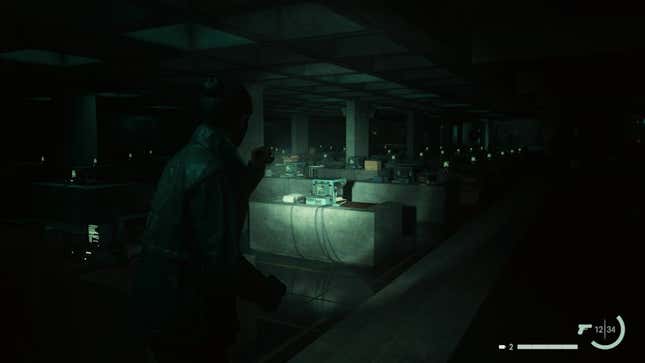After the crowning achievement that is Alan Wake 2, you’d think developer Remedy Entertainment would take a break. Yet in the subsequent expansions to the 2023 survival horror game, the studio has poked and prodded further at the base game’s thesis, teasing out even more fascinating aspects of its world. The Lake House, the final DLC for Alan Wake 2, does this poking with exceptional style and an eye towards discussing one of the industry’s hottest topics of debate: AI’s role in art. As a goodbye to one of the best AAA games in recent memory, it’s a triumph.
Those familiar with the base game might remember The Lake House’s protagonist, Kiran Estevez, as the Federal Bureau of Control agent who helps Saga along her journey. Told through narration, The Lake House recounts Estevez’s investigation into the titular location, an FBC facility that has gone dark. Like Night Springs, the first of AW2’s expansions, The Lake House is a bite-sized experience that will take you only two to three hours to complete. That’s perfect, as it lets Remedy tell a more concise story with a clear point of view.
Despite being more closely connected to 2019’s Control than anything else in AW2, don’t expect The Lake House to play like that supernatural action game. Estevez isn’t packing special powers, just a pistol and a flashlight. As in the base game, you’ll collect a few more weapons along the way (including an entirely new armament) to fight off the now-infected inhabitants of the Lake House. As a conclusion to the AW2 experience, The Lake House clearly wants to challenge you, boasting some tough fights against large groups of enemies made even tougher by a seemingly abysmal amount of resources throughout the facility. If you aren’t careful, you’ll find yourself with an empty clip and no other option than to face your inevitable death and restart with a better plan.
The expansion’s titular facility gives The Lake House its own aesthetic identity, one that’s far more in line with Control. This is an FBC building, after all, and as soon as you walk inside its concrete lobby, the sleek brutalist architecture might almost make you feel like you’re back in the Oldest House. The enemies you encounter within the facility, like the weapons you find, are mostly rehashes of what you saw in the base game, a bunch of zombie-like figures who’ve been infected by the Dark Place. There is, however, something else lurking within the Lake House: looming humanoid figures dripping with paint that jump out of canvases to kill you. The Lake House itself is decorated with countless paintings and graffiti across its walls (alongside lots of blood).
The physical art you encounter around every corner in the Lake House represents the facility’s (and the expansion’s) continued obsession with the artistic process. Unlike Wake himself, and many other important figures in the extended lore of the series, the major players in The Lake House are not artists themselves, yet they are preoccupied with the production of it. The competing co-heads of the facility, whose story The Lake House truly is, conducted experiments in an effort to harness Wake’s ability to reshape reality through art, a path which ultimately plunged the building into chaos.
As you explore the levels of the Lake House, you’ll read emails and memos about two dueling projects, both of which seek to quantify the emotion of an artistic piece in some objective manner that can then be replicated. One researcher attempts this by dragging in a painter and forcing him to adhere to an inhuman production schedule to create the correct art for triggering a supernatural power like Wake’s. The opposing project believed that it could recreate the outcome of Wake’s writing through observation, measurement, and replication.

One of the most striking environments in The Lake House is a sprawling open office filled with dozens—maybe hundreds—of automated typewriters trained on pages written by Wake that the FBC recovered. The mechanical whirring of machines and cacophonous clicking of keys produces countless pages of text. In a room off to the side you can find a white board on which researchers graded each resulting page on metrics like tone, style, readability, etc. There is a constant desire to define what makes something “art.”
It’s a not-at-all subtle takedown of artificial intelligence in tech, specifically products like ChatGPT that scrape the work of real creators in order to produce empty facsimiles of art that impress only the most unimaginative people. Remedy beats you over the head with the sheer stupidity of both the Lake House experiments and their real-life counterparts. Signs plastered on the walls encourage workers to not decorate their desks and remind them that “art is for analysis.” At one point, a page written by Wake describing the projects within the Lake House reads “art was not art, just content for the experiment.”
That’s Alan Wake 2’s final message to audiences. Art is not content. It’s a word that’s become so much more prolific across cultural discussions in recent years as the proponents of AI push us toward conceiving of every piece of art as simply a product for viewer enjoyment rather than a thing that can challenge your worldview. Games are not content. Writing is not content. Art is not content. Those who create are not cogs in a machine to be used and disposed of or turned into food for an algorithm. The Lake House is Remedy’s clear statement that the push to quantify and replicate art without emotion is nothing short of a horror story. As far as farewells go, it’s a pretty fucking good one.
.
